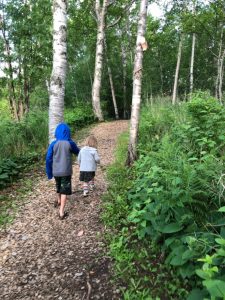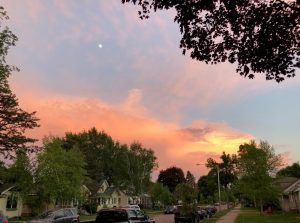Written by Kristina Frugé
As we move through Lent, into Holy Week and eventually Easter, Christian communities across the globe are moving through story of Jesus’ life, death and resurrection as they gather together. This three-part blog series by Riverside Innovation Hub Program Manager, Kristina Fruge, reflects on how we struggle to steward the gift of this complex but beautiful story and why we must continue to come alongside each other in our call to live into its promise.
The first post of this series leaned into the truth of life and death’s necessary relationship and the complicated beauty of being called to be a dusty people. This second post reflects on how often Christian communities forget their dusty calling and replace it with musty practices and habits.

I remember as a young child playing in my Granny’s basement on rainy days when the backyard garden was too soggy for rowdy kids to explore. The cement floor was cold on my bare feet, and the cinder block walls were lined with stacks of boxes and other household items. There was enough room to run and play in the dim light and even kick a dodgeball around for a modified version of soccer with my brothers. These rainy days would bring a burst of energy into what was, on most days, an unlively place. Our shouts of child’s play would cut through the musty air that filled the space—the thick fragrance of time and artifacts of my grandmother’s life and family’s history that had been hidden from the light and elements for years. When the sun would return to dry out the neighborhood, we’d rush up the stairs and out the screen door to join the lady slippers, dragonflies, pine trees, and cardinals playing and alive in the backyard.
Granny’s house and neighborhood hold many of my earliest memories. It was one of several places I felt at home growing up. Another home away from home for me has been the church. The particular faith communities have changed over the years, but together these communities nurtured within me a sense of groundedness in understanding my purpose and identity through the story of Jesus. There have been times in my life when I forgot who I was and whose I was. It was the story of Jesus showing up in my life—through a faith community, a friend, or even a stranger—that helped me remember. I am a child of God, and so is my neighbor—and, this world doesn’t work if we don’t love each other and ourselves as God so dearly loves us all.
I have deep roots within the church and its people. I hold in tension an immense gratitude for the church and a deep heartache for the ways we, as the church, have too often played it safe and fallen short. I have witnessed and contributed to the ways we, as the church, have grown musty in our ways and our places. Much of what I have experienced in this church often reminds me more of my grandmother’s basement than her backyard.
In my experiences of worshiping in and working with the church over the years, it has often felt like an underlying goal of the church is to recruit people to our team, our activity, or our faith. This objective is not always explicit. However, the desire to see people participating in our churches in the ways we have enjoyed being a part of the church seems to, functionally at least, be shaping where leaders and congregations invest much time and energy. Getting people to show up for our stuff is seen as a marker of health and success. If it’s not happening enough, we are anxious and work harder to get people to come. If people are showing up, we assume we’ve found the solution to buck the trend of declining church participation and just need to keep doing more and better of the same thing. But if how we measure “success” or health is based on how many and how often people show up for our stuff, then we have forgotten who we are called to be.
We cannot forget.
The gospel in fact displays a much different way of being church. We are the ones who are supposed to show up—in the world, in relationships, in places of brokenness, of community, of complexity. We are a dusty people, and this should propel us to live boldly and humbly in the unsheltered and uncertain places. Remembering our dusty calling should embolden us to not be afraid of death or loss because we know it’s only part of the whole story, and the whole story is God’s and it is good.
When we forget these truths we are tempted to let cultural markers of success or anxiety about our survival motivate our actions. We default to habits and ways of being church that are musty.
Musty and dusty should not be confused with each other. Both connote a sense of agedness, but one has seen the light, and the other has not. Musty things may have been dusty things when they came to be—ways to worship or be in relationship with others or gather community in ways that were meaningful at the time. But they haven’t been given space to let the light, the neighbor, or the elements shape or change them. Musty things do change, in their own way. The longer they are removed from the impact of the world around them, the less vibrant they become, the less life they hold or offer. They may even pick up an unpleasant odor. They lose their impact, significance, and transformative power because we remove them from a relationship with a world that places demands on us. Yet, we MUST keep them around as they are, inadvertently assuming it’s the thing that brings life—the way we worship, the program we built, the ministry structure that worked, or the building that has housed a particular worshiping community.
We forget.
It is not the buildings or programs or things we’ve made that are the source of life and promise and joy. The Holy Spirit’s activity in the world is not contingent on the church’s participation. At best, we work to pay closer attention so we can point to the work of the Spirit and get caught up in it. At times this means we need to get out of the way.
We can also nurture spaces and invest in relationships where the Holy Spirit can show up and do what She does. These spaces and places of community and relationship in its many forms create the gaps in our lives and assumptions where God can get to work touching, transforming, healing, reconciling. When we hold on to the musty practices and programs, we miss the point. We focus on the wrong thing. And stuff starts to stink. The gaps for the Spirit to work within and through get smaller and smaller. We rigidly work to maintain ways of being church that focus on preserving buildings, leadership structures, programs and our sense of control and this distracts from where God is pleading for us to focus—on people, on creation, on the dust present in death and new life.
What is one musty thing in your congregation? What would happen if your congregation got to the work of letting it become dusty? What if we took that musty practice or belief or program out of the basement, into the light and the world and risked how it might be impacted, challenged, or transformed by encountering the neighborhood? Would we be willing to risk even the death of our musty ways, trusting that death and dust are a needed part of new life?

The reality of death hits close to home for a declining church, but this absolutely does not mean God’s activity and love in the world is in decline. In the wake of death, we dusty people know that good news is rising to take its first breath. As dusty people we can trust this good news and even participate in it. If we remember who and whose we are, we can let our musty ways die. This is sacred and faithful work. We can lean into the truth of our dusty calling, remembering, not forgetting, that when things die they give over their space and energy for new life to emerge.
The rain is letting up, and the neighborhood is eager for us to burst through the doors, into the sun, and breath in new life together with creation.
